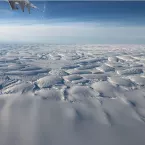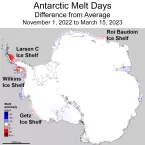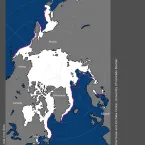Our Research
As climate changes, how do Earth's frozen areas affect our planet and impact society?
In this section
Related News & Stories
Filter by:

Feature Story
By Brigitta Rongstad

Analysis - Snow Today
Extensive snow cover in the western United States continued in March 2023, surpassing the 2019 record high by 11 percent and doubling last year's average and the 23-year-satellite record average for snow-covered area for March.

Analysis - Sea Ice Today
Sunlight has returned to the highest latitudes in the Arctic, while in the Antarctic autumn is settling in.

Spotlight
In 2006, NSIDC and Argentine researchers landed on two icebergs calved off the Antarctic Peninsula and installed a battery of science instruments on each. NSIDC then tracked the movement of these icebergs as they drifted northward into warmer waters and broke apart.

Analysis - Ice Sheets Today
The Antarctic Peninsula has had an intense melt season with above average melting persisting through much of February. Saturated snow from a high melt year and low sea ice in Bellingshausen Sea have led to a series of minor calving events on the Wilkins Ice Shelf. Elsewhere in Antarctica, melting was near average.

Analysis - Sea Ice Today
Arctic sea ice has likely reached its maximum extent for the year, at 14.62 million square kilometers (5.64 million square miles) on March 6.